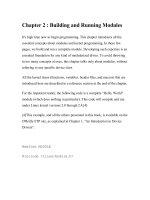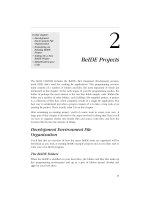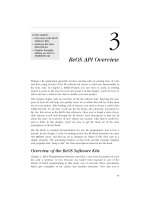Operating System: Chapter 2 - Processes and Threads
Bạn đang xem bản rút gọn của tài liệu. Xem và tải ngay bản đầy đủ của tài liệu tại đây (5.18 MB, 55 trang )
Chapter 2
Processes and Threads
2.1 Processes
2.2 Threads
2.3 Interprocess communication
2.4 Classical IPC problems
2.5 Scheduling
1
Processes
The Process Model
• Multiprogramming of four programs
• Conceptual model of 4 independent, sequential processes
• Only one program active at any instant
2
Process Creation
Principal events that cause process creation
1. System initialization
2. Execution of a process creation system
3. User request to create a new process
4. Initiation of a batch job
3
Process Termination
Conditions which terminate processes
1. Normal exit (voluntary)
2. Error exit (voluntary)
3. Fatal error (involuntary)
4. Killed by another process (involuntary)
4
Process Hierarchies
• Parent creates a child process, child processes
can create its own process
• Forms a hierarchy
– UNIX calls this a "process group"
• Windows has no concept of process hierarchy
– all processes are created equal
5
Process States (1)
• Possible process states
– running
– blocked
– ready
• Transitions between states shown
6
Process States (2)
• Lowest layer of processstructured OS
– handles interrupts, scheduling
• Above that layer are sequential processes
7
Implementation of Processes (1)
Fields of a process table entry
8
Implementation of Processes (2)
Skeleton of what lowest level of OS does when an
interrupt occurs
9
Threads
The Thread Model (1)
(a) Three processes each with one thread
(b) One process with three threads
10
The Thread Model (2)
• Items shared by all threads in a process
• Items private to each thread
11
The Thread Model (3)
Each thread has its own stack
12
Thread Usage (1)
A word processor with three threads
13
Thread Usage (2)
A multithreaded Web server
14
Thread Usage (3)
• Rough outline of code for previous slide
(a) Dispatcher thread
(b) Worker thread
15
Thread Usage (4)
Three ways to construct a server
16
Implementing Threads in User Space
A userlevel threads package
17
Implementing Threads in the Kernel
A threads package managed by the kernel
18
Hybrid Implementations
Multiplexing userlevel threads onto
kernel level threads
19
Scheduler Activations
• Goal – mimic functionality of kernel threads
– gain performance of user space threads
• Avoids unnecessary user/kernel transitions
• Kernel assigns virtual processors to each process
– lets runtime system allocate threads to processors
• Problem:
Fundamental reliance on kernel (lower layer)
calling procedures in user space (higher layer)
20
PopUp Threads
• Creation of a new thread when message arrives
(a) before message arrives
(b) after message arrives
21
Making SingleThreaded Code Multithreaded (1)
Conflicts between threads over the use of a global variable
22
Making SingleThreaded Code Multithreaded (2)
Threads can have private global variables
23
Interprocess Communication
Race Conditions
Two processes want to access shared memory at same time
24
Critical Regions (1)
Four conditions to provide mutual exclusion
1.
2.
3.
4.
No two processes simultaneously in critical region
No assumptions made about speeds or numbers of CPUs
No process running outside its critical region may block
another process
No process must wait forever to enter its critical region
25









